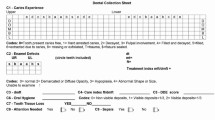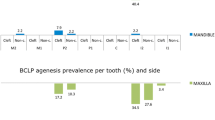Abstract
AIM: To compare the prevalence of dental caries in children with cleft lip/palate with national data at the same age. METHOD: Ethical approval was granted from the West of Scotland Ethics Committee. Children attending the Oral Orthopaedic Clinic were examined for caries according to the criteria of the British Association for the Study of Community Dentistry (BASCD) by two trained and calibrated examiners (KB, RW). Subjects were divided into five age groups: 0.5–1.49; 1.5–2.49; 2.5–3.49; 3.5–4.49 and 4.5–6.0 years. Mean dmft scores were compared with available national data (National Dental Inspection Program of Scotland) for nursery [NDIP 3-year-old survey 2008, unpublished] and 5-year-old children in Scotland [NDIP, 2008]. RESULTS: 209 subjects were examined (participation rate of 87.4%); 45.9% were female, 54.1% male; 21 children (10%) had a recognised syndrome and were reported separately. Cleft Palate (CP) was the most commonly occurring cleft in both syndromic and non-syndromic groups, followed in decreasing numbers by Unilateral Cleft Lip and Palate (UCLP), Bilateral Cleft Lip and Palate (BCLP), Unilateral Cleft Lip (UCL) and Bilateral Cleft Lip (BCL). The only age group with a significantly higher level of dental caries compared with national data was the 4.5–6.0 year-olds where only 37.2% of the children with clefts were caries free compared with the national figure of 57.7% (p=0.004). This same age group had a mean dmft for the cleft group of 3.24 compared with 1.86 nationally. The other age groups had similar dmft and percentages of subjects caries free compared with the national data. The differences did not reach significance. Caries was more common in the anterior teeth of the youngest two age groups, but in the posterior teeth of the two oldest age groups. CONCLUSION: By the age of 4.5 years, children with cleft lip/palate in the West of Scotland have significantly more caries than their non-cleft peers.
Similar content being viewed by others
References
Ahluwalia M, Brailsford SR, Tarelli E, et al. Dental caries, oral hygiene, and oral clearance in children with craniofacial disorders. J Dent Res. 2004;83(2):175–9.
Al-Wahadni A, Alhaija EA, Al Omari MA. Oral disease status of a sample of Jordanian people ages 10 to 28 with cleft lip and palate. Cleft Palate Craniofac J. 2005;42(3):304–8.
Bokhout B, Hofman FX, van Limbeek J, Kramer GJ, Prahl-Andersen B. Incidence of dental caries in the primary dentition in children with a cleft lip and/or palate. Caries Res. 1997;31(1):8–12.
Bokhout B, Hofman FX, van Limbeek J, Kramer GJ, Prahl-Andersen B. Increased caries prevalence in 2.5-year-old children with cleft lip and/or palate. Eur J Oral Sci. 1996;104(5–6):518–22 Dec.
Chapple JR, Nunn JH. The oral health of children with clefts of the lip, palate, or both. Cleft Palate Craniofac J. 2001;38(5):525–8.
Clark JD, Mossey PA, Sharp L, Little J. Socioeconomic status and orofacial clefts in Scotland, 1989 to 1998. Cleft Palate Craniofac J. 2003;40(5):481–5.
Dahllof G, Ussisoo-Joandi R, Ideberg M, Modeer T. Caries, gingivitis, and dental abnormalities in preschool children with cleft lip and/or palate. Cleft Palate J. 1989;26(3):233–7; discussion 237-8.
Gregg TA, Johnston D, Pattison KE. Efficacy of specialist care for caries in the cleft child. Int J Paed Dent. 1999;9(Suppl 1):61.
Hasslöf P, Twetman S. Caries prevalence in children with cleft lip and palate-a systematic review of case-control studies. Int J Paed Dent. 2007;17(5):313–9.
Hewson AR, McNamara CM, Foley TF, Sandy JR. Dental experience of cleft affected children in the west of Ireland. Int Dent J. 2001;51(2):73–6
Kirchberg A, Treide A, Hemprich A. Investigation of caries prevalence in children with cleft lip, alveolus, and palate. J Craniomaxillofac Surg. 2004;32(4):216–9.
Lauterstein AM, Mendelsohn M. An analysis of the caries experience of 285 cleft palate children. Cleft Palate J. 1964;29:314–9.
Mitropoulos C, Pitts NB, Deery C. BASCD Trainers’ Pack on Caries Diagnosis. Dental Health Services Research Unit, Dundee, 1992.
Mossey PA, Davies JA, Little J. Prevention of orofacial clefts: does pregnancy planning have a role? Cleft Palate-Craniofac J. 2007;44(3):244–50.
Mutarai T, Ritthagol W, Hunsrisakhun J. Factors influencing early childhood caries of cleft lip and/or palate children aged 18 to 36 months in southern Thailand. Cleft Palate Craniofac J. 2008;45(5):468–72.
National Dental Inspection Programme of Scotland. Report of the 2008 Survey of P1 Children. http://www.scottishdental.org/index.aspx?o=2153.
Parapanisiou V, Gizani S, Makou M, Papagiannoulis L. Oral health status and behaviour of Greek patients with cleft lip and palate. Eur Arch Paed Dent. 2009;10(2):85–9.
Paul T, Brandt RS. Oral and dental health status of children with cleft lip and/or palate. Cleft Palate Craniofac J. 1998;35(4):329–32.
Pitts NB, Evans DJ, Pine CM. British Association for the Study of Community Dentistry (BASCD) diagnostic criteria for caries prevalence surveys-1996/97. Community Dent Health. 1997;14(Suppl 1): 6–9.
Scottish Index of Multiple Deprivation, http://www.Scotland.gov.uk/topics/statistics/SIMD.
Stec-Slonicz M, Szczepanska J, Hirschfelder U. Comparison of caries prevalence in two populations of cleft patients. Cleft Palate Craniofac J. 2007;44(5):532–7.
Womersley J, Stone DH. Epidemiology of facial clefts. Arch Dis Child. 1987;62(7):717–20.
Wong FW, King NM. The oral health of children with clefts-a review. Cleft Pal-ate Craniofac J. 1998;35(3):24–54.
Author information
Authors and Affiliations
Corresponding author
Rights and permissions
About this article
Cite this article
Britton, K.F.M., Welbury, R.R. Dental caries prevalence in children with cleft lip/palate aged between 6 months and 6 years in the West of Scotland. Eur Arch Paediatr Dent 11, 236–241 (2010). https://doi.org/10.1007/BF03262754
Published:
Issue Date:
DOI: https://doi.org/10.1007/BF03262754




